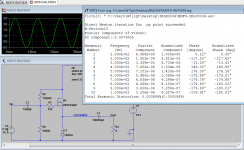I made these kind of amps 10 years ago, experimented with the huge 120mH/4A , I tried mosfet source follower like here, but CFP follower sounded lot better imo. It`s few parts more, so you could easily try it if you want to experiment.
Pass DIY Addict
Joined 2000
Paid Member
Cool looking design Michael - Time to label another zip-lock bag of parts and put it in the "future projects" box...
Thanks for sharing!
Thanks for sharing!
I woke early this morning so I played a little with the MoFo amp in LTSpice.
In simulation the IRFP7430 gave much less THD and a much nicer distortion spectrum with less higher order harmonics.
With 19,3 volts (typical Laptop) power supply, 1,7 ampere current 5 + 5 volt @ 100 Hz over a 8 ohm load, and 50 mH 0,5 ohm choke I got the following numbers:
IRFP7430 = 0,017% THD and only second and third harmonics visible in the FFT.
IXYS IXTK200N10 = 0,031% THD and a visble fifth harmonic in the FFT.
IRFP054V = 0,066% THD and a visible fifth harmonic in the FFT.
This is not very surprising due to the unique "Triodity" of the IRFP7430.
I am very tempted to buy a pair of Hammond chokes.. I love the extreme simplicity, and I know from previous similar projects that it can sound excellent.
Cheers,
Johannes
In simulation the IRFP7430 gave much less THD and a much nicer distortion spectrum with less higher order harmonics.
With 19,3 volts (typical Laptop) power supply, 1,7 ampere current 5 + 5 volt @ 100 Hz over a 8 ohm load, and 50 mH 0,5 ohm choke I got the following numbers:
IRFP7430 = 0,017% THD and only second and third harmonics visible in the FFT.
IXYS IXTK200N10 = 0,031% THD and a visble fifth harmonic in the FFT.
IRFP054V = 0,066% THD and a visible fifth harmonic in the FFT.
This is not very surprising due to the unique "Triodity" of the IRFP7430.
I am very tempted to buy a pair of Hammond chokes.. I love the extreme simplicity, and I know from previous similar projects that it can sound excellent.
Cheers,
Johannes
Did you compare (in Spice) the 7430 with the IRLP3034
No, not in this amp. I have been playing with the IRLB3034 (a TO220 equivalent to IRLP3034) and it does not look as nice in simulation.
I prefer the IRLP3034 in common source amps, while the IRFP7430 is better in common drain amps (imho).
Regards,
Johannes

I have been testing the MoFo amp in LTSpice but with a larger choke.
I tried the IRLB3034pbf (TO220 equivalent of IRLP3034) and the simulated distortion is vanishingly low. I don't believe these low distortion values, but I do believe the general trend of very low THD from these low Vds - high transconductance parts like the IRLP3034, IRFP7430 among others.
A Hammond choke is not as good as the simplified spice-part, and a loudspeaker is a reactive load. The distortion will not be this low, but I do expect significantly less distortion then from an IRFP150/250.
Cheers,
Johannes
A toriod transformer may work but you will want to measure the inductance. Like I have a 110v to 12.5 v 110va transformer. My cheap chinese inductance meter measures the primary at about 500mh and the secondary at 7 mh and while this meter may be way off it still tells me that secondary won't have enough inductance. And someone mentioned cheap common mode chokes. I am afraid those just won't work for us here. They are intended for filtering high frequency noise as you see from the inductance being quoted at typicaly 10khz .
A toriod transformer may work but you will want to measure the inductance. Like I have a 110v to 12.5 v 110va transformer. My cheap chinese inductance meter measures the primary at about 500mh and the secondary at 7 mh and while this meter may be way off it still tells me that secondary won't have enough inductance. And someone mentioned cheap common mode chokes. I am afraid those just won't work for us here. They are intended for filtering high frequency noise as you see from the inductance being quoted at typicaly 10khz .
Thank you for this comment.
I was a bit afraid my idea was just too cheap. 😱
I had studied a couple of datasheets of these common mode chokes. Especially the graphs showing the frequency behavior made me worry. Not a lot of inductance left at lower frequencies.
🙁
I also found information on how to calculate the inductance of a toroid. This gave me second thoughts on this idea. You need rather big toroids to get this right. And the core saturation caused by just a tiny bit of DC current (mentioned in ZV7-T) is also something to keep in mind. Back to the basic Hammond choke it is. 🙄
The big Hammond lump is only mildly over-size for the SE form, depending how much bass power you expect from a dozen Watts.
In push-pull, 2 lumps, double the weight/cost.
In push-pull, ONE lump CT, you can probably use 1/4 the weight (and cost) due to flux cancellation and less need for gap.
I really do NOT believe the $3 CM chokes can support this amp. I can not pinpoint the "why", except the iron (ferrite) has to DO something, and you don't get much stuff for $3.
Power transformer is hopeful. We have about 12V RMS each side or 24V RMS bridged. Normally we must work audio far below the Voltage we accept for power iron, because distortion bothers us but not the power company. In this case the fat MOSFET may allow use of a 24VAC CT winding for OK 50Hz power, or a 48V CT winding for excellent clean power toward 30Hz.
In push-pull, 2 lumps, double the weight/cost.
In push-pull, ONE lump CT, you can probably use 1/4 the weight (and cost) due to flux cancellation and less need for gap.
I really do NOT believe the $3 CM chokes can support this amp. I can not pinpoint the "why", except the iron (ferrite) has to DO something, and you don't get much stuff for $3.
Power transformer is hopeful. We have about 12V RMS each side or 24V RMS bridged. Normally we must work audio far below the Voltage we accept for power iron, because distortion bothers us but not the power company. In this case the fat MOSFET may allow use of a 24VAC CT winding for OK 50Hz power, or a 48V CT winding for excellent clean power toward 30Hz.
Anyone going to BAF who could help me by taking some nice hi-res pictures and gathering a little info for the aX write-up? 🙂
I'm sure I could think of a nice reward of some sort.
I'm sure I could think of a nice reward of some sort.
8 ohm load. Memory's slipping. Gotta check on the generator impedance when I get back to the lab this weekend. 🙂
That's with a 50 ohm generator, so with a 150 source impedance you're around -4dB at 200kHz, and with a 600 ohm source, you're at -2dB at 40kHz. That's all with the smaller 50mH 193T. 🙂
big bada$$ chokes for neon bulbs (200W and upwards) can be handy , with some grinding
they're usually welded (E to I stack) , so all you need is to grind weld line , and organize proper spacer and clamping
just saying , for cheapskates with full shelves
they're usually welded (E to I stack) , so all you need is to grind weld line , and organize proper spacer and clamping
just saying , for cheapskates with full shelves
Michael Just Fantastic!!!!! Simple and cheap to build.
Could the MOFO concept be adjusted to use say IXFN140N20P Mosfet.
Regards Steve.
I built one with the IXFN44N80P. 🙂
Thank's Michael do you still favour the IRFP250.
The temptation was just too much so have ordered the parts to build the MO-FO! Will there be any PCBs for purchase in the near future.
Steve.
The temptation was just too much so have ordered the parts to build the MO-FO! Will there be any PCBs for purchase in the near future.
Steve.
- Home
- Amplifiers
- Pass Labs
- Build This MoFo!

